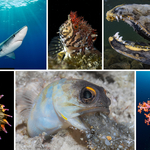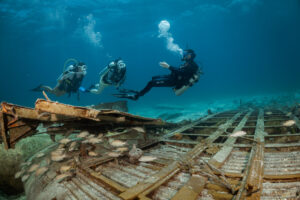
Anytime a diver is considering a dive destination one of the more common questions they have is, “What is the best time of the year to dive there?”. In Cozumel one could argue that just about any time of the year is great diving – and they would not be wrong. However, if you were asking me, I would narrow it down to January and February, maybe into March as well. “Why,” you might ask? Because Eagle Rays!
Admittedly, I am a huge fan of Eagle Rays (Aetobatus sp.), so I can have my bias here. But if you are like me and go into a trance-like state when you see the elegance of an eagle ray, then you do not want to miss winter in Cozumel. Although you can find eagle rays year-round in Cozumel, the summertime can be rare sightings due to the warmer water temepratures. Eagle rays prefer water below 80-82 degrees Fahrenheit (near 27 Celsius). This means the cooler winter waters of January – March the eagle rays come to Cozumel in big numbers. And it is not just numbers, but also size. It is the big adult females (and the smaller males – but still big!) coming to both feed and mate.
There is little chance you will not see an eagle ray or twelve during January and February. Off the walls you can find the rays gliding south to feed in the sand flats. Eagle rays are generally solitary in nature but can occasionally be found in pairs while feeding. If you somehow make it through a dive and do not see them on the reef worry not. As you complete your 3-minute safety stop you will likely see several feeding in the shallow open sand flats. The rays will ignore you and keep feeding as you drift overhead. This provides a great opportunity to observe their feeding habits, marvel at their hypnotic patterns, or snap photographs you can submit to the Cozumel Ocean Research Foundation for tracking purposes. Did you know the spots of an eagle ray are as unique to them as fingerprints are to humans?
Maybe you are an experienced diver and you have you seen an eagle ray or two in your day. Are you ready to take it to the next level? By utilizing one of the dive centers located in the north harbor you can get the chance to dive the famed north side of Cozumel and find yourself in schools of 20 – 50 Eagle Rays!
The north wall of Cozumel is known for strong currents, so this is not a dive for inexperienced divers. However, it is these strong currents which attract the huge numbers of large adult eagle rays. With little exception the north wall runs predominantly north-south. However, on the dive site we have named Eagle Ray Alley, there is one spot in the wall where the flat, vertical wall has a feature shaped much like the letter “S.” The top of this wall is about 70 feet / 21 meters deep. As the current moves briskly south to north it will slam into the front face of the S-curve.
When this happens most of the current gets shoved down and around the face of the S-curve, effectively creating a dangerously strong down draft of current. However, the water column from 70-90 feet / 21 – 27 meters gets forced up the wall. This, my friends, is where the magic happens. Eagle rays school in big numbers on this updraft and hang near-motionless. Perhaps nowhere else in the world can you regularly expect to see such large numbers of schooling eagle rays.
There are a couple considerations before jumping onto this dive. First, the northern part of Cozumel is not commonly dove as most dive operators depart from the south. Because of this you will need to select an operator departing from the north harbor of Puerto Abrigo. Another consideration is lodging. Most of the resorts of Cozumel are located to the south of the island. Again, this makes dives to the north difficult to locate as none of the operators of the south will be willing to drive south to get you an then head north. To solve both concerns you can review these Cozumel all-inclusive resort dive packages. This dive operator has boats in the north, plus has dive packages with every resort in Cozumel – both the north and south resorts. This combination is an unbeatable combination which makes it easier to coordinate this breath-taking dive.
Speaking of travel, it is worth noting that Cozumel is completely open to tourism since June 10, 2020 without restrictions currently. While travel numbers are down, this has made for a quiet island and incredible diving. If you have been to Cozumel in the long past you may deeply appreciate the current vibe of the island. Without cruise ships, it is the Cozumel of old. Which should make all divers excited!
You will find more information about Cozumel and mexico on MyDiveGuide.
Written by Henry C. Schultz – Salty Endeavors Scuba Center
Source images: Robert Stansfield
The post Cozumel – the best time to dive here appeared first on Dive SSI.
Read MoreDiving, Cozumel, eagle rays, mexicoDive SSI




